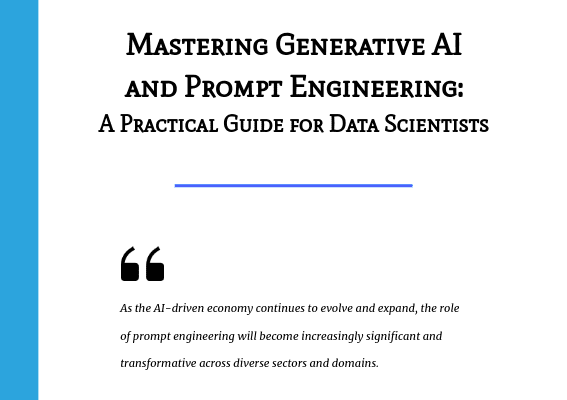Mastering Generative AI and Prompt Engineering: A Free eBook
In short, generative AI — and the prompts that power them — are everywhere. But beyond the basics, what do you really know about either? Perhaps you would find a concise, focused ebook on the topics useful.

Mastering Generative AI and Prompt Engineering: A Practical Guide for Data Scientists ebook cover
Since its release in late November 2022, ChatGPT has taken over personal, professional, and public discourse. Everyone has been talking about it, what it can do, how we can leverage it... and why we should fear it.
GPT stands for Generative Pre-trained Transformer, referring to a family of large language models (LLMs) that are trained on existing text data and are able to statistically predict the next word or token in a sequence of words. When stated like this, it really doesn't sound like much. But GPT is already having far-reaching effects on how we live, work, and play. I don't even need to cite anything here because you are familiar with numerous instances.
GPT (and other LLMs) are not the only generative AIs. There were natural language processing models prior to their existence that we able to perform similar tasks, some still in use today. However, state of the art in such tasks is now the sole territory of GPT, and they have caught on like wildfire in the recent few months even though they existed in lesser forms for years prior to the ChatGPT explosion.
Text is not the only generative models around, either. You have likely heard of, and used, image generation models such as DALL-E, Stable Diffusion, and Midjourney. They, too, rely on well-crafted prompts in order to perform useful generation.
In short, generative AI — and the prompts that power them — are everywhere. But beyond the basics, what do you really know about either? Perhaps you would find a concise, focused ebook on the topics useful. If so, Mastering Generative AI and Prompt Engineering: A Practical Guide for Data Scientists from Data Science Horizons is a great place to start.
This ebook will delve into the key concepts, best practices, and real-world applications of generative AI and prompt engineering. It will explore the capabilities and limitations of popular AI models, detail the process of designing effective prompts, and discuss the ethical considerations that arise when working with these technologies. [...] By the end of this ebook, you will have gained a solid understanding of generative AI and prompt engineering, enabling you to apply these techniques to your own projects effectively.
The book will dive into "key concepts, best practices, and real-world applications of generative AI and prompt engineering." Excellent. But maybe we should first more clearly clarify what these 2 separate but related topics are, so that there is no misunderstanding. Here is what the ebook defines generative AI to be:
Generative AI encompasses a range of models and techniques designed to generate new data based on existing input data. These models have demonstrated significant capabilities in natural language processing, image generation, and more. By understanding the mechanics and intricacies of generative AI, data scientists can harness its power to create innovative solutions for a multitude of problems.
A definition of prompt engineering is given as:
Prompt engineering, on the other hand, deals with the art of crafting effective prompts to guide AI models in generating desired outputs. As AI models become more sophisticated, the need for efficient and precise prompt engineering has grown more critical. By mastering this skill, data scientists can better direct AI models to produce targeted results, ultimately enhancing the efficacy of their applications.
We are promised a look at concepts, best practices and applications of the above, but what about practical implementations? Is this a prompt manual? While the book covers some specific prompt examples, it does a better job giving a higher level view of the topics of generative AI and prompt engineering. Its major chapters are:
- Understanding Generative AI
- Introduction to Prompt Engineering
- Practical Applications of Prompt Engineering
- Challenges and Limitations of Prompt Engineering
- Future Directions and Emerging Trends in Prompt Engineering
- Practical Tips and Best Practices for Prompt Engineering
Among the guidance that is provided, it's good to see that, in the new era of unrealistically high expectations for (and fears of) GPT, their limitations are realistically addressed. From ethics to predictability, some of the major concerns are mentioned to ensure that the reader has been made aware of, and can further study, them.
While prompt engineering can significantly enhance the performance and usability of generative AI models, it's essential to acknowledge the inherent limitations and biases present in these models. Understanding these limitations can help data scientists set realistic expectations, make informed decisions, and develop more robust and reliable AI solutions.
If you want to learn more about leveraging generative AI by mastering prompt engineering, check out the free ebook Mastering Generative AI and Prompt Engineering: A Practical Guide for Data Scientists right away. It has a lot of useful information, can be digested rather quickly... and the price is right. You might find it to be the guidebook on the topic for which you have been searching.
Matthew Mayo (@mattmayo13) is a Data Scientist and the Editor-in-Chief of KDnuggets, the seminal online Data Science and Machine Learning resource. His interests lie in natural language processing, algorithm design and optimization, unsupervised learning, neural networks, and automated approaches to machine learning. Matthew holds a Master's degree in computer science and a graduate diploma in data mining. He can be reached at editor1 at kdnuggets[dot]com.
